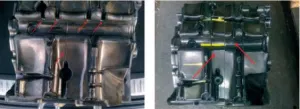 The study shows that considerable reserves still exist for increasing the service times of CrN-coated dies for Al hot extrusion. The main reasons for the decreased service times are revealed and explained regarding the selected CrN-coated die for hot extrusion, i.e. why the service time of the coated-die is not in accordance with the wear resistance of the CrN-coating. The shaping of the bearing surface and presence of the scratches, size and amount of nonmetalic inclusions in the die steel, nodular defects in the CrN-coating, as well as thicknesses uniformity of CrN-coatings along the bearing surface, are relevant influential parameters.
The study shows that considerable reserves still exist for increasing the service times of CrN-coated dies for Al hot extrusion. The main reasons for the decreased service times are revealed and explained regarding the selected CrN-coated die for hot extrusion, i.e. why the service time of the coated-die is not in accordance with the wear resistance of the CrN-coating. The shaping of the bearing surface and presence of the scratches, size and amount of nonmetalic inclusions in the die steel, nodular defects in the CrN-coating, as well as thicknesses uniformity of CrN-coatings along the bearing surface, are relevant influential parameters.
Archives du mot-clef Die casting
Premature cracking of dies for aluminum alloy die casting
 An interesting paper of Bogdan Pawlowski, AGH University of Science and Technologie in Krakow, published in « Archives of Metallurgy and Materials » :
An interesting paper of Bogdan Pawlowski, AGH University of Science and Technologie in Krakow, published in « Archives of Metallurgy and Materials » :
Two identical dies for aluminum alloy die-casting failed prematurely because of a number of parallel cracks on the working surface. These cracks were of a mechanical nature related to incorrect microstructural banding orientation of the die core and related to improper heat treatment. The root cause of premature cracking of dies was improper heat treatment (temper embrittlement).
Analyse de défaillance d’un cas de fatigue thermique sur un laiton moulé
Dhouha Melloulia, , Nader Haddara, Alain Kösterb, Hassine Ferid Ayedia
| a | Laboratory of Industrial Chemistry and materials, National Engineering School of Sfax, Box1173, W3038, Sfax, Tunisia |
| b | Centre des matériaux Pierre Marie Fourt, Ecole des Mines de Paris |
Abstract
This research has been conducted to elucidate the mechanisms of brass die casting failure. A die was examined and we have evaluated the causes of crack failure mechanisms after use in brass die casting. The dominating failure mechanism in the investigated die was thermal fatigue cracking. Crack initiation is associated to accumulation of the local plastic strain that occurs during each casting cycle. The crack growth is facilitated by a number of elements: oxidation of the cracks’ surfaces, filling of brass and softening of the die material.
